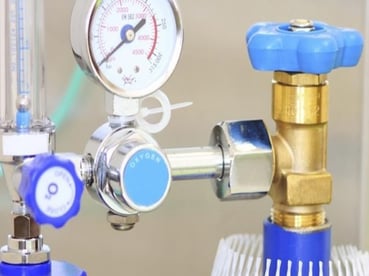
Oxygen is present in the air, in diatomic form, in concentrations that fluctuate at around 20%. We also know that oxygen is one of the fundamental elements of the combustion process and that it can cause explosions or fires.
In many industrial processes, the isolation and control of the concentration of this chemical element requires some fundamental precautions both for the success of the process itself and for the safety of the plants. Let's look at the role of oxygen-compatible lubricating greases.
Gaseous oxygen at room temperature is stable in diatomic form. It has a very strong oxidising power and acts as an oxidising agent in almost all combustion processes. Yet, oxygen is the fundamental link in the combustion reaction.
think of a lit candle in a container - simply closing the container with a lid will quickly extinguish the flame, which will fade until being fully extinguished precisely due to the progressive "consumption" of the oxygen present in the combustion chamber.
How can lubrication negatively interact with oxygen?
To understand how a lubricant can interact with oxygen, we can give an example. Let's try to list the fundamental players in a simple combustion reaction of methane, which is a flammable organic molecule present in our subsoil:
CH4 + O2 = CO2 + H2O
In this basic chemical reaction, the main players are Methane and Oxygen which, in the presence of an energetic trigger, are transformed into carbon dioxide and water, producing energy in the form of a flame. The ignition of the combustion thus requires:
- A flammable substance (in this case methane)
- Oxygen (present in the atmosphere)
- Energetic ignition (spark or open flame)
Now let's imagine replacing methane with another flammable organic substance, such as an oil or a lubricating grease, and imagine wrapping the shutter of a regulator valve of an oxygen supply system with this. Specifically, the use of a lubricant is necessary to reduce the actuating forces of the valve.
What consequences could arise if a spark is generated in the valve itself due to an eddy current propagated inside the system?
The spark could generate rapid combustion, being much more explosive than that produced at atmospheric pressure, due to the high pressure to which oxygen is subjected in the supply circuit.
So what are the criteria for a correct assembly of mechanical components?
- Removal of organic substances from all surfaces
- Uses of self-extinguishing materials
- Use of flame-free lubricants
The ASTM D-92 standard specifies that all (or almost all, as we will see in the next paragraph) industrial lubricating fluids are characterised by a flame point: expressed in ° C, it represents the temperature at which a lubricating fluid generates a flame in the presence of an energy source of a certain entity.
Compatible oxygen greases: examples of applications
There are mechanical devices that need to be wrapped in a lubricating fluid for their operation and which, for the requirements of the process, are found to operate in the presence of oxygen at high pressure:
- Sub-oxygen pressure regulators
- Gearmotors
- Shut-off valves
- Pneumatic valves
- Mechanical devices operating inside hyperbaric chambers
How to solve the problem of combustion in contact with oxygen?
Within the family of synthetic lubricating fluids is a category of lubricating oils and greases whose thermal degradation occurs in the absence of combustion and flame propagation. This means that, even in the presence of a high concentration of oxygen, the risk of combustion (or even worse, of explosions) is averted.

Characteristics of an oxygen-compatible grease
The main characteristics that a good oxygen-compatible lubricant must have are:
- Flame-free (therefore, flammable)
- Characterised by a broad range of operating temperatures
- Compatible with plastics and elastomers
- Suitable for the lubrication of mechanical components in contact with oxygen at high pressure
- Characterised by a high thermo-oxidative stability
- Free from organic compounds



